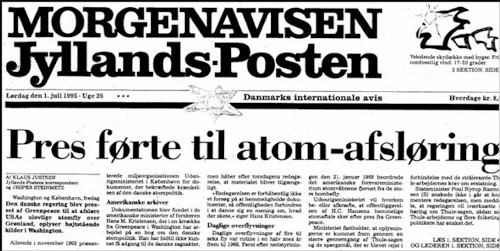Denmark's Thulegate:
U.S. Nuclear Operations in Greenland |
 |
Until recently, Danish governments insisted that the United States adhered to
Denmark's non-nuclear policy. The policy prohibits nuclear weapons on Danish
territory including Greenland and the Faeroe Islands. Yet during the 1990s,
documents declassified and released in the United States under the Freedom of
Information Act revealed that U.S. Strategic Air Command bombers armed with
nuclear weapons overflew Greenland on a daily basis for most of a decade between
1958 and 1961. The political scandal that followed these disclosures lasted five
years and was called Thulegate.
One of the bombers crashed on the ice off Thule Air Base in January 1968,
triggering suspicion and accusations that Denmark's nuclear ban was routinely
violated. Both U.S. and Danish government officials insisted at the time,
however, that the aircraft had approached the area because of an emergency and
that it had not been in Greenland airspace prior to the accident. The
declassified documents, however, revealed that not only had the ill-fated bomber
overflown Greenland prior to the accident, it had been loitering right
above Thule Air Base as part of a top-secret mission to monitor the important
BMEWS-radar, a vital element in U.S. nuclear war planning.
The disclosure prompted the Danish government to conduct an internal review of its records
(see figure 1). The
review uncovered documents that not only confirmed a violation of the
non-nuclear policy but also could serve to explain why. The result of the review
was a four-page report presented to the Danish parliament in June 1995. The
report not only confirmed the overflights, but concluded that the United States
had acted in good faith. The report put the blame on the late Danish Prime
Minister H. C. Hansen, who during a 1957 meeting
with the U.S. Ambassador had refrained from stating Danish non-policy when asked
if Denmark wanted to be informed in case the United States decided to deploy
nuclear weapons in Greenland. In doing so, the report concluded, Hansen gave the
United States a tacit go-ahead.

Figure 1: "Pressure resulted in nuclear disclosure," Jyllands-Posten, July 1,
1993, p. 1.
Shortly after the report was released, U.S. Defense Secretary William Perry
visited Denmark. After meeting with Perry, Danish Foreign Minister Niels Helveg
Petersen assured the press that while nuclear weapons had overflow Greenland, it
was certain that no nuclear weapons had ever been deployed on the ground. Yet
only a few days later, Petersen received a
letter from the U.S. government which informed that an internal
investigation showed that nuclear weapons had in fact been deployed on the
ground. Deeply embarrassed and faced with a major scandal, the Danish government
decided to make the information public. A semi-independent investigation was
commissioned that was given access to previously declassified documents from the
Danish archives.
Although the U.S. government declined to grant any special declassification
favors to the Danish investigation, the available information provides
sufficient information to outline the extent of the U.S. deployment of nuclear
weapons in Greenland. This is based on the following five bodies of documents:
As a result of the information released in the many cases described above, it
is possible to detail the deployment of U.S. nuclear weapons in Greenland:
|
U.S. Nuclear Weapons In
Greenland |
|
Weapon Type |
Years Deployed |
|
At Thule Air Base |
|
| 4 Mk 36 Mod 1 |
Feb-Dec 1958 |
| 15 Mk 6 (no
capsule installed)* |
Feb-Dec 1958 |
| 48 W31/Nike
Hercules SAM |
Dec
1959-Jul 1965 |
| W54/Falcon
(GAR-11)* |
~1961-mid 1965 |
|
Airborne** |
|
B28/B53 bombs on
daily Chrome
Dome
and Hard Head missions |
Jul 1961-Jan 1968 |
* The
Mk6 bombs are not mentioned in the 1978 History of U.S. nuclear
deployments, but are identified in the U.S. government's July 1995
letter to the Danish government. The W54 weapons for the F-102A aircraft
of the 332nd Fighter-Interceptor Squadron are also not mentioned in the
History, but Air Force documents indicate they were present at Thule,
something also concluded by the Danish government's investigation.
** Weapons on Chrome Dome airborne alert aircraft and Hard Head Thule
Monitor missions are approximate but considered to have been almost continuously
present over Greenland given the daily frequency of the flights. |
Despite such disclosures, this chapter in U.S.-Danish nuclear relations is
still officially shrouded in secrecy. Although Denmark has released much
information, other remains secure in the vault. And the United States continues
to classified some information about nuclear operations in Greenland as if
nothing had been released in Denmark. After 30-40 years, every reasonable
national security interest served by withholding references to nuclear
operations in Greenland has lost its meaning. ©
Hans M. Kristensen |
www.nukestrat.com |
2004
|

